#Airbus CEO
Explore tagged Tumblr posts
Text
#Airbus CEO#New engine technology#Engine technology#Airbus engines#CEO optimism#Technology verdict#Aerospace technology
2 notes
·
View notes
Text
AirBus CEO on why SpaceX model may not work in Europe: Elon Musk's space is not pleasing anybody except ... - Times of India
Airbus CEO Guillaume Faury has reportedly expressed concerns over the potential anti-trust implications of a SpaceX-like model in Europe. He highlighted the stark contrast between the European space industry, characterized by its fragmented approach and stringent regulations, and SpaceX’s highly integrated and innovative model. According to a report by news agency Reuters, “I think what the…

View On WordPress
0 notes
Text

Airbus CEO vs NEO
5 notes
·
View notes
Text

Welcome Captain Anderson and First Officer Connor!
About a week and a half ago I came up with dbh civil aviation au, as I absolutely love jetliners. So I decided to combine both of my interests! :D
More details about the setting are under the cut!
In the 2020s, a new aerospace corporation emerged - “Cyberair”. Originally starting from light jet construction, but later in the 30s they introduced narrow-body aircraft to the production line, as the result of rapid growth and market expansion. However, throughout the years their idea remained the same: “Reliable and comprehensive automation”. Cyberair jets are everything, beyond what a modern aircraft can offer, and is capable of. Truly a creation of the 21st century.
The latest Cyberair venture – state of the art autopilot. Identical to humans in its appearance, yet so different in behaviour. It’s efficient, reliable and doesn’t make mistakes (almost. At least human ones). But to tell the truth, this development is expected – ever since the late 20s Cyberair started to slowly announce machine cabin crew, even gifting a unique RK200 air traffic controller model to the Detroit Metropolitan Airport.
Delta Air Lines received their own one-of-a-kind autopilot, a RK800 (FAA approved!) model. How? Well, something about the Cyberair CEO liking their service. After a few papers signed and a few hands shaken, Connor embarks on his first real flight as a First Officer.
No plane flies without a captain though, so Connor has company. And a superior. Even if machines are better than people in piloting the plane in almost every way, human ego and fear, maybe, can’t let them be in absolute control. “Uncanny valley” or something.
Captain Anderson is a highly experienced senior pilot at Delta. Most of his career he has been flying Airbus aircraft, piloting A350-900 in the later years. Although because of Connor working with him now he has to pilot Cyberair regional or light jets from time to time. Oh, those signed papers be damned… He misses his dear A350.
Their relationship had a rough start, with the captain calling Connor “an attempt of capitalism at stealing my job”. But Hank couldn’t help but warm up to the FO the more flight hours passed. There was something so… alive about him? No, in aviation you only trust your instrument panel, and here all of the facts loudly state that Connor is simply a RK800. This is definitely some Eliza effect shit.
Why is he so interested in the A380 then? Doesn’t he have all of the aeroplane data neatly stored in his head? What surprises Hank more is something akin to confusion on Connor’s face every time he gets overly excited about the giant of the skies. Maybe he’s surprised by his new-found interest, too. At least there’s something Hank can tell him about from the old days (ah, proud A380 pilot) during long transatlantic flights.
Fucking Eliza effect bullshit.
P.S. if you want to leave an ask about this au, please do! I get asks so rarely so I’m excited hahah. But you can ask literally anything else, too lol
#art#fan art#my art#dbh#detroit become human#connor rk800#dbh connor#dbh rk800#rk800#dbh hank#hank dbh#hank anderson#dbh au#dbh aviation au
473 notes
·
View notes
Text
No. 9 - IndiGo
A very different type of bonus review - I'm here to stop talking about history and start talking about current events. Nobody has requested IndiGo, but IndiGo has requested that Airbus sell them a record-breaking 500 A320-family aircraft as an absolutely wild opening to this year's Paris Air Show. That is, to put it in context, the largest bulk order of jets by an airline ever, in history. While aircraft orders by companies are generally negotiated behind closed doors and thus I can't say how much money is actually changing hands, the approximate value of this deal is hypothetically 55 billion US dollars.
This will more than double IndiGo's existing 308-strong fleet, consisting of A320-family jets and ATR-72 turboprops. They are already the largest operator of the A320neo in the world, and have a truly stunning 999 aircraft on order.
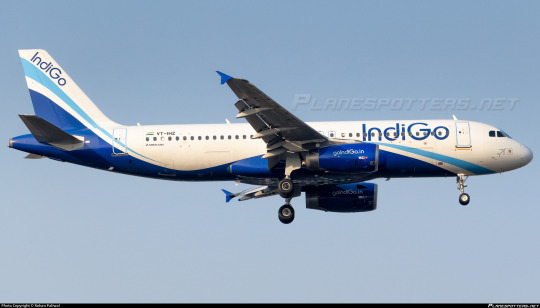
Well. Assuming nothing changes, we will have a thousand more of these in the world by 2035. How do I feel about that?
Those living in the West might not be familiar with IndiGo (full name InterGlobe Aviation Ltd., not to be confused with defunct United States carrier Indigo Airlines; callsign "IFLY", not to be confused with Russian charter airline I-Fly) but even without this truly prodigious order they're pretty massive. In fact, they're the largest carrier in the world's most populous country. Currently headed by the former CEO of KLM, they are also the largest low-cost carrier in all of Asia.

It's interesting, but somehow this livery doesn't feel like it has much gravitas to it. That's fine for a low-cost carrier, it just feels a bit surreal that this is the current record-holder for largest bulk order of aircraft. Not the Delta-American-United triad, who already have 1,000+ aircraft fleets. Not Emirates and its massive A380 and 777 fleets. Not even a huge flag carrier looking to expand. They're not even a full-blown ULCC, and I could have imagined Ryanair making an order of this magnitude to try and rapidly expand way before I would have bought it from IndiGo. My guess would be that they're feeling a bit threatened by the two massive threats of the Lions Air and Airs Asia, but that's just speculation and also not what I'm here to talk about. I just cannot stop being astounded by this. I don't feel like any airline needs 500 aircraft total, but what would I know?

One neat little touch I'd like to point out is that this plane feels like it had a lot of thought put into how it's seen from the bottom. In particular, the little stick figure/airplane dot thing(?) IndiGo logo is on the bottom, and the little blue swooping line is made an active part of the design under the nose, rather than just trim, the same way as it is on the tail. The logo in particular is super recognizable. I will say, though, the way that it's just dots could probably make people mistake it for some sort of safety lighting rather than iconography, because it does resemble the sort of markers you'd see on the ground at a runway.

Seriously, what is that logo? Is that an airplane? I think it's supposed to be an airplane but it is so simplified it's no longer instantly recognizable.

The font used for the wordmark is ITC Bauhaus, which, sure, that's nice and big and striking, and its branding has not changed since 2006. The color...sure is indigo, though the actual livery on the airplanes pretty heavily skews towards general blue. (We're done with jetBlue, but blue jets will haunt me forever, it seems.) I wish it was a bit bolder on the actual fuselage, because it's a bit hard to read at times with how thin the letters are.
That said, I have to point it out: Indian carrier operating primarily domestic flights in India, which will mostly be flown on by Indian people, the majority of whom will speak Hindi (the fourth most spoken language on the planet), and yet has the airline's name and website in English but not Devanagari. (EDIT: I have been told by somebody who actually lives in India that English is probably the more broadly accessible choice for a lot of the country, so this is actually not an issue.)
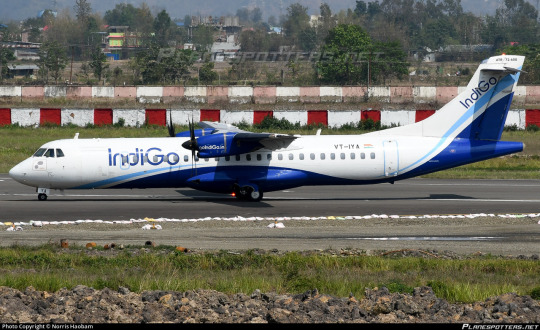
I kind of wonder if ATR operators are drawn to dark swooping curves on the bottom of their planes, because Azul had the same sort of basic shape around the belly fairing. I think it looks good on the type, don't get me wrong, I'm just curious now if that does factor into the thought process.
I think this livery is exactly as busy as it needs to be. It pinches in neatly under the nose, and I like how it travels up to cover the lower half of the tail. It feels uncommon to see that sort of tail-fuselage integration. It's nice how the light blue line alternately joins and diverges from the darker main body, creating a dynamic feeling, and I like how it's used as almost a rule for the placement of the logo on the tail. (I do wonder why the little plane logo couldn't go there instead, though. Or on the nacelles. Its absence everywhere except the belly seems weird. There actually is a small one on the nose under the windows, but if you can't see it from a distance I don't think it counts.)
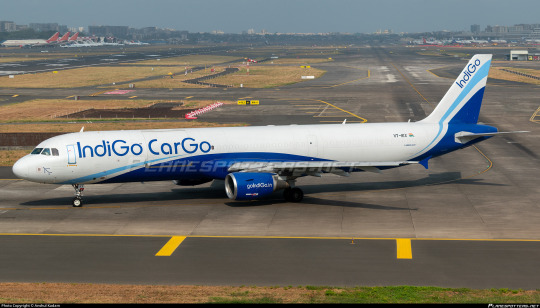
The airline operates a total of two freighters, but I just want to point out the commitment to the Go bit, which I like. It's a lot less of a common branding thing than you'd expect, honestly. Surprised more airlines haven't jumped on that.

I really love seeing prop covers on planes. Those are her gloves.
I'm not sure how I feel about the fact that the blue fully retreats in that little center-back fuselage section. From a few angles you get just a sliver of it visible in a way that feels awkward, but in theory I do like it. A bit of white breaking up that line isn't a bad thing.
Grade: C+
As in, we will c +500 of these in the next twenty years.
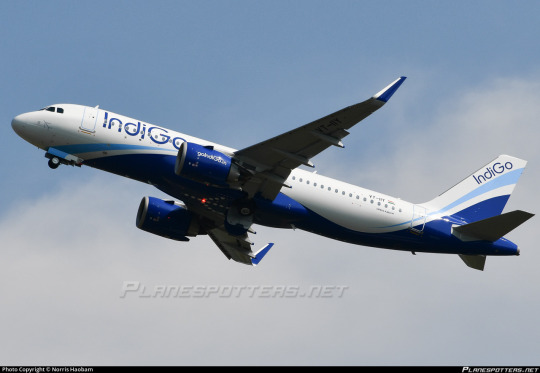
Well, this has been just a fun little extra. It's a good thing I don't totally hate this, because 500 more of these are about to be flying to an airport near you! (More airports near more people, because I think 1,200 planes for just their current 101 destinations would be serious overkill). What an exciting start to the Paris Air Show, and I live in fear that I'll be forced to rush to my keyboard again when [throws dart] Binter Canarias announces that they [spins wheel] are going to start operating a fleet of secondhand A380s.
#tarmac fashion week#grade: c+#region: asia#region: south asia#region: india#era: 2000s#era: 2010s#era: 2020s#indigo#low cost carriers
34 notes
·
View notes
Text
I’m not a financial advisor, I’m mostly only saying this because I fucking hate Boeing, but if you own stock in Boeing rn you should sell it and buy stock in Airbus. And then take your receipts and send them to the President and CEO of Boeing and tell him to swallow rocks and quit his job here’s his email address - [email protected]


https://www.seattletimes.com/business/boeing-aerospace/boeing-wants-faa-to-exempt-max-7-from-safety-rules-to-get-it-in-the-air/
7 notes
·
View notes
Text

Airbus Readies Upgraded MRTT As U.S. Mulls Tanker Recapitalization
tanker refueling
Airbus is looking to build on its success selling the A330-based tanker to Australia and other countries with a new version using the A330neo airframe.
Credit: U.S. Air Force
Airbus is getting ready to launch a major upgrade of its A330 widebody-based military refueling aircraft that would give it more competitive firepower for a potential new round in the U.S. tanker war.
The European aircraft manufacturer could give the go-ahead before year-end to the A330neo-based Multirole Tanker Transport Plus (MRTT+) to replace its current A330-based tanker. The new version would be about 8% more fuel-efficient, extending its edge against its main competitor, Boeing’s KC-46A, Airbus officials say.
USAF secretary says “no final decision” on KC-135 replacement effort
New Airbus tanker could provide 2,160 nm range
Airbus’ MRTT+ could arrive just as the U.S. Air Force is looking for a new round of tankers to replace much of its KC-135 fleet, although the ultimate shape of that program remains uncertain. The service in March 2023 rolled out its KC-135 recapitalization project, which aims to field an upgraded tanker following the end in 2029 of the ongoing KC-46 program of record. The project involves purchasing 183 Boeing tankers, with options for five more, ahead of the planned arrival of the Next-Generation Aerial-Refueling System in 2040.
But Air Force Secretary Frank Kendall, speaking at the Farnborough International Airshow on July 22, said there’s “no final decision” on what the KC-135 recapitalization will look like and that the service will soon finalize a study on a future clean-sheet tanker. Funding remains an open question. The service earlier had said it expected to set an acquisition strategy this summer.
Kendall’s comments come as the Air Force finalizes its fiscal 2026 budget request, which will likely determine the plan’s future. Kendall and others have signaled that the budget will be tight for modernization, potentially putting the tanker plan in limbo.
Boeing and Airbus have submitted bids for the KC-135 replacement program. Airbus had teamed with Lockheed Martin for the effort, but the U.S. company pulled out last fall after the Air Force presented its requirements.
Supplying the service with tankers has been a particularly brutal battle between the two aircraft behemoths. Airbus initially won an Air Force tanker competition in 2008, teaming with Northrop Grumman. Boeing protested the decision, which was upheld by the Government Accountability Office, and then won the recompetition with the KC-46A, although it has since lost billions of dollars on the program.
Airbus expects demand for about 161 tankers through 2033, with about 42% in the U.S. The Asia-Pacific region, the Middle East and Europe are the next-largest markets, says Jean-Brice Dumont, head of air power at Airbus Defense and Space. “There is a significant market ahead of us.”
Airbus Defense and Space CEO Michael Schoellhorn says the MRTT+ should be particularly attractive to the U.S. Talks continue, but he notes: “There is currently no clear path as to whether or not there will be a competition. We stand available, but we also go after the rest of the world market.”
The company would not reveal its bid strategy, but Dumont says: “It is obvious you go to the U.S. with U.S. partners.”
Airbus expects to deliver its first A330neo-based aerial-refueling tankers before the end of the decade. The company is already undertaking risk reduction efforts to turn the A330-800, which features Trent 7000 engines and an enhanced wing, into a tanker. This phase aims to ensure that changes, such as to the wing and engine, do not upset the system’s functionality. That effort has provided “a high level of confidence” that the A330neo could be used as a tanker, says Maria Angeles Marti, head of tanker, transport and mission programs at Airbus Defense and Space.
Airbus says the MRTT+ will have greater range, but customers can also use the efficiency gains to increase refueling capacity. Boeing has countered that the KC-46’s smaller size makes it a better fit for many military bases.
Airbus is also working on other tanker upgrades, with an eye to improving the MRTTs already delivered. One key enhancement the company is introducing is automated refueling using the boom. Airbus has validated daytime operations with the Republic of Singapore Air Force. In recent weeks, Airbus had conducted tests involving more than 500 refueling contacts at night that should enable it to get certification for nighttime operations early next year, Marti says.
Airbus is exploring further automation that would enable the tanker to control the aircraft, crewed or uncrewed, during refueling. The company is also studying the ability to turn the tanker into a battlefield communications node and enhance its self-protection suite to improve survivability.
“We have customers interested, and we have customers in a hurry,” Dumont says of the MRTT+ upgrade program. The new tanker will be launched with a customer, he says, which would kick off a roughly four-year development program.
Robert Wall is Executive Editor for Defense and Space. Based in London, he directs a team of military and space journalists across the U.S., Europe and Asia-Pacific.
@Aviationweek.com
5 notes
·
View notes
Text

Log #386
Our flight back to MNL last night was unusually turbulent. Besides my excitement for flying with 5J’s new Airbus A321 CEO, my heart raced because the aircraft was shaking for almost half of the 60-minute flight. I found out that there’s an LPA along the path of our flight upon watching the news when we arrived home.
I’ll be flying back to PPS next week to meet with the DOH Undersecretary Vergeire. In relation to this, I released a memo to my AO (Administrative Officer) and AA (Administrative Assistant) later today to mandate every department to prepare and make efforts in tidying up their respective areas.
Anyway, I took a break today so I could extend my lifespan.
5 May 2023 12:44 AM Quezon City, Philippines
9 notes
·
View notes
Text

Airbus A330-200 Virgin Australia
Registration: VH-XFC Named: Mooloolaba Beach Type: 330-243 Engines: 2 × RR Trent 772B-60 Serial Number: 1293 First flight: Feb 28, 2012
Virgin Australia, the trading name of Virgin Australia Airlines Pty Ltd, is an Australian-based airline. It is the largest airline by fleet size to use the Virgin brand. The airline's headquarters is based in South Bank, Queensland. It was co-founded by British businessman Richard Branson (the founder of Virgin Group), and former CEO Brett Godfrey. The airline commenced services on 31 August 2000 as Virgin Blue. In 2011, the airline went through a massive transformation—the changing of its brand to Virgin Australia. In addition to the new name, branding and livery, the airline also showed off its new flagship the Airbus A330 with new domestic business class.
Poster for Aviators. aviaposter.com
3 notes
·
View notes
Text
Airbus CEO optimistic about upcoming engine Technology verdict
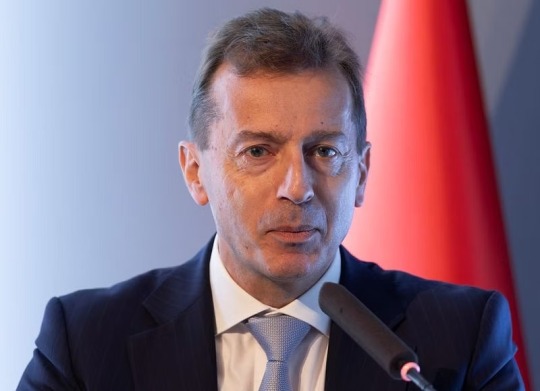
At the Global Aerospace Summit, Airbus CEO Guillaume Faury highlighted the promising potential of CFM International's new open-rotor technology, noting its potential for increased efficiency and reduced emissions. However, he also pointed out the uncertainty surrounding its commercial viability.
Faury also addressed ongoing delays in the delivery of the current generation LEAP engines from CFM International, stating, “They are behind schedule with their deliveries.” CFM has yet to respond to these comments.
In July, Airbus, the world's largest aircraft manufacturer, issued a profit warning and cut its delivery target by 30 units to a total of 770 aircraft. This reduction was due to supply-chain disruptions affecting components like engines and cabin interiors, with LEAP engines experiencing particularly severe delays.
CFM International, a joint venture between GE Aerospace and France's Safran, is a leading jet engine manufacturer by sales volume. Its LEAP engines power all Boeing 737 MAX aircraft and approximately half of the Airbus A320neo fleet, competing with Pratt & Whitney for airline contracts.
READ MORE
#Airbus CEO#New engine technology#Engine technology#Airbus engines#CEO optimism#Technology verdict#Aerospace technology#news#marketing#success#ceo#business
0 notes
Text
Boeing CEO Kelly Ortberg says the company's staff 'spend more time arguing' than strategizing about how to beat Airbus: report
New Post has been published on Sa7ab News
Boeing CEO Kelly Ortberg says the company's staff 'spend more time arguing' than strategizing about how to beat Airbus: report
“Everybody is tired of the drumbeat of what’s wrong with Boeing. I’m tired of it and I haven’t been here that long,” Ortberg said at an all-hands meeting.
... read more !
0 notes
Text
Boeing CEO Kelly Ortberg says the company's staff 'spend more time arguing' than strategizing about how to beat Airbus: report
New Post has been published on Douxle News
Boeing CEO Kelly Ortberg says the company's staff 'spend more time arguing' than strategizing about how to beat Airbus: report
“Everybody is tired of the drumbeat of what’s wrong with Boeing. I’m tired of it and I haven’t been here that long,” Ortberg said at an all-hands meeting.
... read more !
0 notes
Text
Airbus CEO says Spirit Aero talks going well but industrial challenges lie ahead
0 notes
Text
Africa's First Airbus A350-1000 Joins Ethiopian Airlines Fleet
(Addis Ababa) – Ethiopian Airlines has received its first Airbus A350-1000, marking a milestone as the first African airline to operate this largest model of the A350 family. The plane, named “Ethiopia: Land of Origins,” landed at Bole International Airport in Addis Ababa on Tuesday. At a welcoming ceremony, Ethiopian Airlines Group CEO Mesfin Tasew expressed optimism about the airline’s…
0 notes

